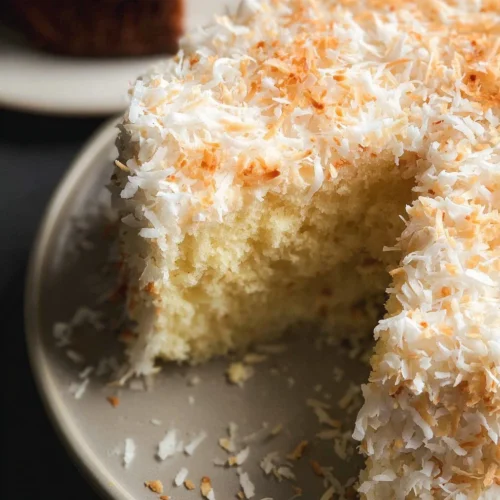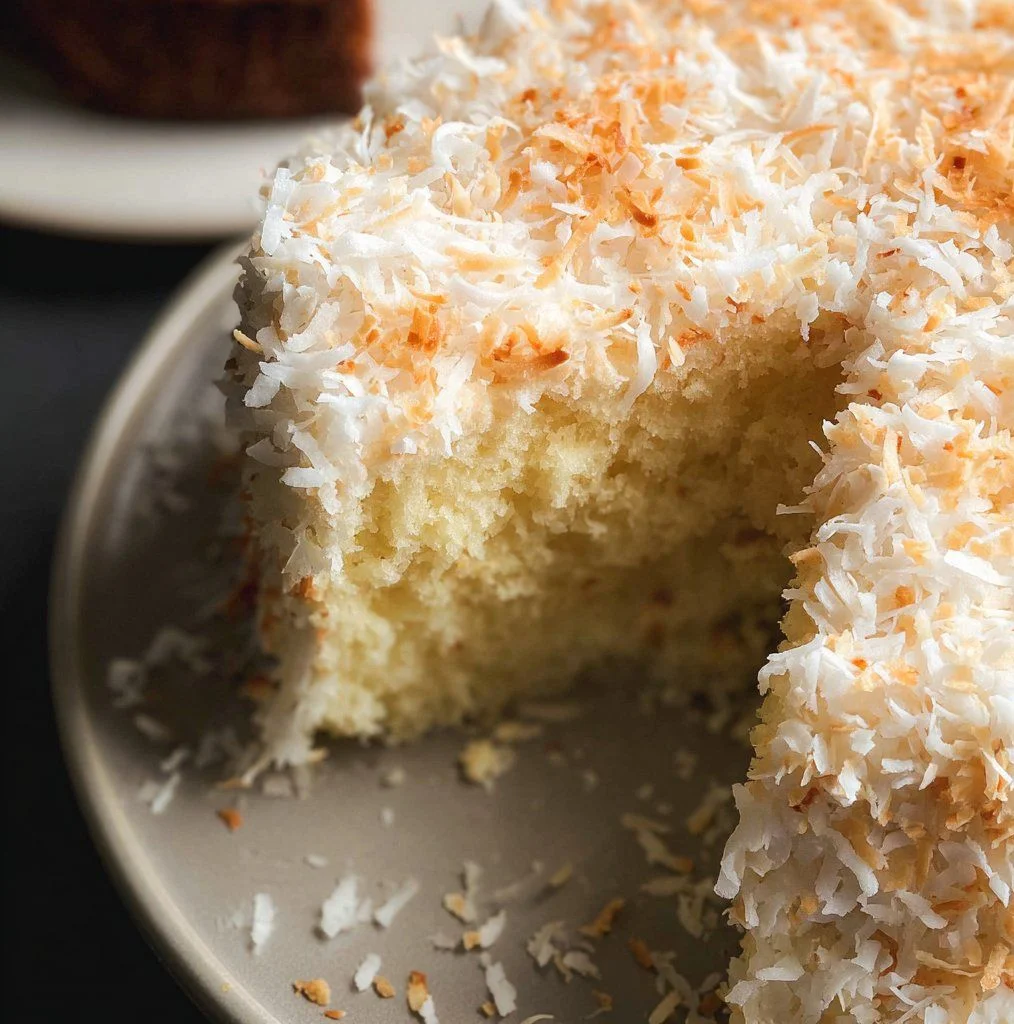Why We Love This Coconut Cake Recipe
What makes this coconut cake stand out is its delightful combination of textures and flavors. The moistness of the cake pairs harmoniously with the rich, creamy frosting, while the incorporation of shredded coconut adds a delightful chewiness. Every slice is a perfect balance of sweet and tropical essence, making it a favorite among coconut lovers and cake enthusiasts alike. The best part? This recipe is straightforward, allowing you to create a delicious dessert without any fuss.
Ingredients about Coconut Cake
To whip up this luscious coconut cake, you will need the following ingredients, each playing a crucial role in the overall taste and texture of the cake:
- 2 1/4 cups all-purpose flour
- 2 1/2 tsp baking powder
- 1/2 tsp salt
- 1 1/2 cups granulated sugar
- 6 Tbsp salted butter, softened
- 1/4 cup cooking oil
- 3 large eggs, room temperature
- 1 tsp vanilla extract
- 3/4 tsp coconut extract
- 1 cup unsweetened canned coconut milk, shaken well
- 1/2 cup sweetened shredded coconut
- 8 oz. cream cheese, softened
- 6 Tbsp salted butter, softened
- 3 cups powdered sugar
- 1 tsp vanilla extract
- 1 tsp coconut extract
- 1 1/2 cups sweetened shredded coconut (for garnish)
How to Make Coconut Cake Directions
Making coconut cake is a rewarding process that fills your kitchen with mouthwatering aromas. Follow these straightforward steps to create this delightful dessert:
Preheat the oven: Begin by preheating your oven to 350°F (175°C). This ensures that your cake will bake evenly.
Combine dry ingredients: In a large bowl, whisk together the all-purpose flour, baking powder, and salt. This mixture forms the foundation of your cake.
Mix the wet ingredients: In a separate bowl, beat the granulated sugar, softened salted butter, and cooking oil together until they’re well combined and fluffy. This step is crucial as it contributes to the cake’s overall texture.
Incorporate eggs and extracts: Add the room temperature eggs, vanilla extract, coconut extract, and coconut milk to the mixture. Blend these ingredients until the batter is smooth, ensuring that everything is well incorporated.
Combine wet and dry mixtures: Gradually add the dry ingredients to the wet ingredients, mixing until just combined. Be careful not to over-mix, as this can lead to a dense cake.
Fold in the coconut: Gently fold in the sweetened shredded coconut. This will add delightful texture and enhance the coconut flavor.
Prepare your cake pans: Lightly grease and line two 8-inch round cake pans with parchment paper. This helps to prevent the cake from sticking and ensures easy removal.
Divide and bake: Pour the batter equally into the prepared pans, ensuring an even distribution. Bake in the preheated oven for 28-30 minutes or until the cakes are golden brown. Test doneness by inserting a toothpick into the center; it should come out clean.
Cool the cakes: Allow the cakes to cool in their pans for about 10 minutes. Then, carefully transfer them to a wire rack to cool completely.
Make the frosting: For the frosting, beat the softened cream cheese and butter together until they reach a smooth and creamy consistency. Gradually add the powdered sugar, vanilla extract, and coconut extract, mixing until fully combined.
Frost the cakes: Once the cakes are completely cooled, frost the top of one cake layer, then place the second layer on top. Frost the top and sides of the entire cake.
Garnish: Finish by generously sprinkling the remaining sweetened shredded coconut on top, giving your cake an inviting, tropical look.
Now, your coconut cake is ready to be sliced and enjoyed!
How to Serve Coconut Cake
Serving coconut cake is an experience in itself. The fluffy layers, creamy frosting, and delightful coconut undertones make it a showstopper for any occasion. You can present it simply on a decorative platter, or if you want to elevate the experience, serve it alongside a scoop of vanilla ice cream or a dollop of whipped cream. Pairing your cake with a hot cup of coffee or a refreshing glass of iced tea can take your dessert experience to the next level.
For something extra special, consider garnishing your servings with fresh fruit, such as slices of pineapple or strawberries, which will enhance the tropical theme. You can also create an elegant presentation by adding a sprinkle of toasted coconut flakes on the side for added crunch.
Expert Tips: Coconut Cake
Creating the perfect coconut cake is a journey, and with a few expert tips, you can elevate your baking skills:
Room temperature ingredients: Ensure all your ingredients, especially eggs and butter, are at room temperature. This helps to achieve a well-emulsified batter, resulting in a lighter cake.
Don’t over-mix: When combining your wet and dry ingredients, mix just until combined. Over-mixing can lead to a dense cake.
Quality coconut milk: Using high-quality coconut milk will enhance the coconut flavor and provide the richness your cake deserves.
Experiment with extracts: Feel free to experiment with the amounts of coconut and vanilla extracts to find the flavor balance that suits your palate best.
Frosting consistency: If your frosting is too thick, add a splash of milk or coconut milk until you reach your desired consistency. Conversely, if it’s too thin, simply add more powdered sugar.
Chill for flavor: Allowing your frosted cake to chill in the fridge for a short time before serving can help the flavors meld beautifully.
How to Store Coconut Cake
Storing coconut cake properly can extend its shelf life and retain its moisture.
At room temperature: If you plan to finish the cake within a few days, you can store it at room temperature. Cover the cake with a cake dome or wrap it in plastic wrap to prevent it from drying out.
In the refrigerator: For longer storage, refrigerate the cake. Cover it in plastic wrap or place it in an airtight container. The cake can last for about a week in the refrigerator.
Freezing: If you want to store your coconut cake for an extended period, consider freezing it. Slice the cake and wrap each piece individually in plastic wrap, then place them in a freezer-safe bag or container. It can be frozen for up to three months. When ready to enjoy, thaw at room temperature.
Variation of Coconut Cake
Coconut cake is a versatile dessert that welcomes creative variations. Here are a few ideas to mix things up:
Layered Coconut Cake: Try making a multi-layered cake by adding additional cake layers. Fill each layer with your choice of frosting or coconut cream for a show-stopping cake.
Coconut Lime Cake: For a zesty twist, add lime zest and juice to the batter and frosting. It adds a refreshing contrast to the sweetness of the coconut.
Chocolate Coconut Cake: Incorporate cocoa powder into your cake batter for a rich chocolate variation. Top it off with chocolate frosting for an indulgent treat.
Pineapple Coconut Cake: Mix crushed pineapple into the cake batter for a sweet, tropical kick. Use pineapple-flavored frosting to enhance the flavor further.
Gluten-Free Coconut Cake: Substitute the all-purpose flour with a gluten-free flour blend to make a gluten-free version that everyone can enjoy.
These variations can be a fun way to personalize your coconut cake and cater to different tastes or dietary preferences.
FAQ Section
What is coconut cake?
Coconut cake is a sweet dessert made with layers of moist cake featuring coconut flavor and often garnished with shredded coconut. Its rich flavor and fluffy texture make it a favorite among cake lovers.
How do I achieve the best coconut flavor?
To achieve the best coconut flavor, use high-quality coconut milk and fresh shredded coconut. Adding coconut extract enhances the flavor profile beautifully.
Can I make coconut cake ahead of time?
Absolutely! You can make coconut cake and store it in the refrigerator a day or two before serving, or even freeze it for future use. Just ensure it’s properly wrapped to keep it fresh.
What should I serve with coconut cake?
Coconut cake pairs wonderfully with coffee, tea, or even a fruit salad. Ice cream or whipped cream can add an extra indulgent touch.
How do I keep my coconut cake moist?
To keep your coconut cake moist, ensure you don’t overmix the batter, and store it properly covered after it cools. The use of coconut milk also enhances moisture content.

Coconut Cake
Equipment
- Oven
- Mixing Bowls:
- Electric Mixer
- 8-inch Round Cake Pans
Ingredients
- 2 1/4 cups all-purpose flour
- 2 1/2 tsp. baking powder
- 1/2 tsp. salt
- 1 1/2 cups granulated sugar
- 6 Tbsp. salted butter softened
- 1/4 cup cooking oil
- 3 large eggs room temperature
- 1 tsp. vanilla extract
- 3/4 tsp. coconut extract
- 1 cup unsweetened canned coconut milk shaken well
- 1/2 cup sweetened shredded coconut
- 8 oz. cream cheese softened
- 6 Tbsp. salted butter softened
- 3 cups powdered sugar
- 1 tsp. vanilla extract
- 1 tsp. coconut extract
- 1 1/2 cups sweetened shredded coconut for garnish
Instructions
- Preheat your oven to 350°F (175°C).
- In a large bowl, whisk together flour, baking powder, and salt.
- In another bowl, beat together sugar, butter, and cooking oil until fluffy.
- Add eggs, vanilla extract, coconut extract, and coconut milk to the mixture, blending until smooth.
- Gradually add the dry ingredients to the wet ingredients, mixing just until combined.
- Fold in the sweetened shredded coconut.
- Prepare two 8-inch round cake pans by greasing and lining them with parchment paper.
- Divide the batter evenly between the prepared pans and bake for 28-30 minutes.
- Once baked, allow the cakes to cool in the pans for 10 minutes before transferring to a wire rack to cool completely.
- For the frosting, beat cream cheese and butter until smooth, then gradually add powdered sugar, vanilla, and coconut extracts.
- Once the cakes are cooled, frost the top of one layer, place the second layer on top, and frost the entire cake.
- Garnish with sweetened shredded coconut on top.
Send me this recipe!
Just enter your email below and get it sent straight to your inbox!



